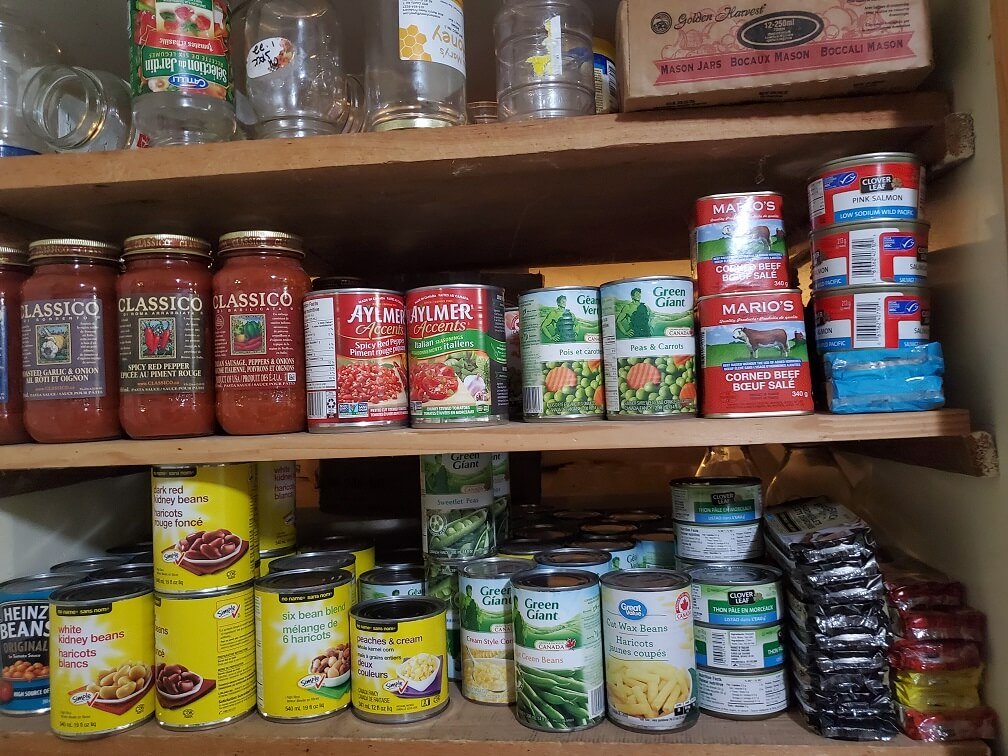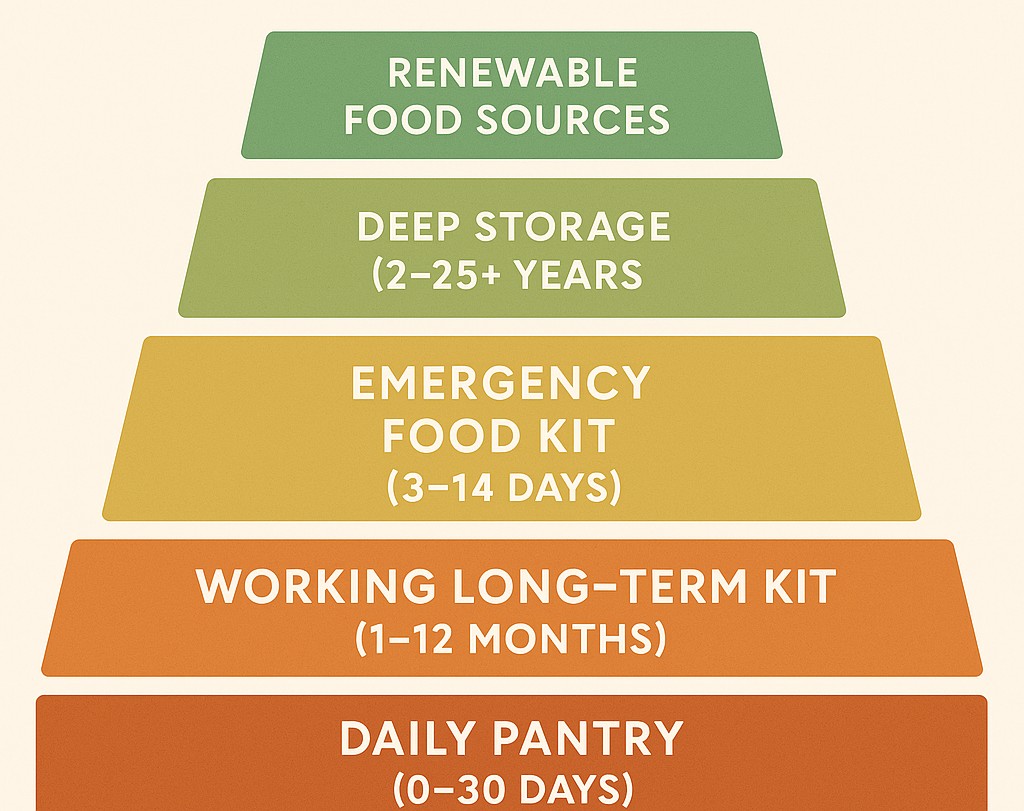🥫 The Ultimate Layered Food Storage Plan for Emergency Preparedness Only part of a complete food storage plan Only part of a complete food storage planTL;DR: The “best” survival food isn’t just what lasts longest — it’s what fits your situation, integrates with your system, supports your health and your mental state, and can adapt over time. In other words you need a layered food storage plan. The idea of the best survival foods to stockpile seems simple at first glance: just choose non-perishable, calorie-dense items, right? But if you dig into this a little you realize that the “best” food depends on much more than shelf life and calories. So what's the answer? I'm a systems kind of guy, so how do we systematically go about building our food storage plan? Let’s expand our perspective and consider nutrition, logistics, psychology, economics, and systems design to arrive at a more satisfying answer. 🧠 Step 1: Define the Purpose of Your StockpileDifferent contexts demand different food strategies. So first, clarify why you’re stockpiling:
Each scenario has different requirements for:
🧠 Step 2: Think in Terms of Systems, Not Just IngredientsFood is part of a survival system. Your stockpile should integrate with:
So "best foods" must be:
🍽️ Step 3: Categorize Food Types FunctionallyLet’s go beyond “canned food” and think in terms of functionality and role in your diet. Here’s a framework:
🧠 Step 4: Apply Nutritional Optimization LogicSurvival food often leans too heavily on carbohydrates. That leads to:
So your smart prepper balances macros:
And includes micro-nutrients (vitamins and minerals) either through:
🧠 Step 5: Consider The Supply Chain and ResilienceStockpiling is a hedge against volatility. So food that is:
…is an important component in addition to the expensive pre-packaged stuff. Resilient options include:
🧠 Step 6: Psychological SustainabilityBoring food equals low morale. Eating the same bland mush every day saps willpower. Incorporate:
🧠 Putting It All Together - Build a Layered Food Security Plan Beyond 'Food Storage' to 'Food Security' Beyond 'Food Storage' to 'Food Security'If you're prepping for uncertain times — from power outages to full-blown societal disruptions — one of the smartest steps you can take is to build a layered food storage plan. This approach helps you stay ready for short-term emergencies, long-term survival, and everything in between. In this section, I’ll break down exactly how to organize your emergency food supply using five practical layers. Each layer serves a different time-frame and purpose, helping you build a resilient and sustainable food storage system. 🧺 Why a Layered Food Storage Plan WorksMost survival food advice focuses only on buying canned goods or freeze-dried meals. But effective food storage isn't just about shelf life; it’s about function, nutrition, morale, and sustainability. By building a layered system, you:
🧂 Layer 1: Daily Pantry (0–30 Days)Goal: Store food you eat every day; fresh, familiar, and frequently rotated. What to Include:
Tip: Use the “store what you eat, eat what you store” rule. This minimizes waste and makes it easy to rotate your emergency food supply. ⛑️ Layer 2: Emergency Food Kit (3–14 Days)Goal: Ready-to-eat survival food for grid-down situations, evacuation, or crisis events. What to Include:
Store in: A waterproof tote or bug-out bag. Keep it accessible in case of sudden emergencies. 🧂 Layer 3: Working Long-Term Reserve (1–12 Months)Goal: A buffer against food shortages, inflation, or job loss. This layer keeps your family fed through medium-term disruptions. Best Long-Term Pantry Foods:
Storage: Use food-grade buckets, Mylar bags, and oxygen absorbers for dry goods. Label everything and rotate every 6–12 months. 🧊 Layer 4: Deep Storage (2–25+ Years)Goal: Strategic reserve for long-term survival situations such as grid failure, war, or major collapse. Best Foods for Long-Term Survival:
Pro tip: Consider professionally packed survival food kits or #10 cans for hassle-free storage. 🌱 Layer 5: Renewable Food SourcesGoal: Develop a system to replenish what you consume i.e. ultimate self-sufficiency. How to Get Started:
Skill tip: Start now with small steps — even a windowsill herb garden counts. ✅ Final Tips for Prepping Your Food Storage
📋 Summary Table: Your Layered Food Storage Plan
🛒 Ready to Start Stockpiling?The best time to prepare was yesterday; the second-best time is now. Whether you're prepping for an emergency, building self-reliance, or just getting smart about your food budget, this layered food storage plan gives you a solid, adaptable foundation. More Resources for 'Food Storage Plan'Chapter 12 - Food Preservation: The Self-Sufficient Backyard Raise chickens, pigs and a productive organic garden: The Homesteader Book Bundle Fresh egg for breakfast (and maybe barter): The Eggs Factory If you need to build it for your homestead, the plans are here: 16,000 Woodworking Plans
|
See Something You Like? Share!
Recent Articles
-
Farm grown reviews of products recommended by New Terra Farm
Dec 04, 25 06:26 AM
Find great farm and garden products in my farm grown reviews -
Best Chicken Coop and Accessories for Small Farms and Homesteads
Nov 30, 25 09:18 AM
Looking for the best chicken coop? Here are the top coops, accessories, nest boxes, and gear to build a safe, productive poultry setup. -
Community Supported Agriculture Marketing Ideas To Sell Out The Season
Nov 05, 25 05:18 AM
Authentic Community Supported Agriculture marketing ideas to grow loyalty, boost sign-ups, and sell out your CSA every year



